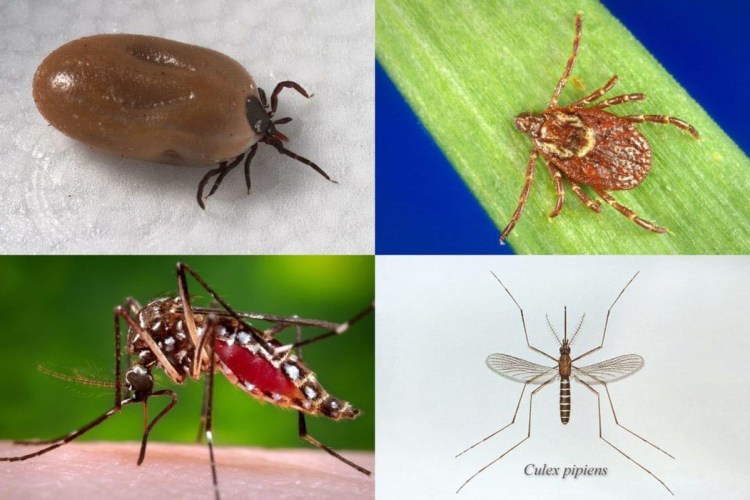The warmer weather of spring and summer means the start of tick and mosquito season and the diseases they transmit, including Lyme disease, Rocky Mountain spotted fever, West Nile and Zika.
A new report from the Centers for Disease Control and Prevention has found that illnesses from mosquito, tick and flea bites more than tripled in the United States from 2004 to 2016.
The report, released Tuesday, shows that the number of reported cases of these diseases jumped from 27,388 cases in 2004 to more than 96,000 cases in 2016. The data include illnesses reported in the U.S. and its territories. During that period, a total of more than 640,000 cases of these diseases were reported to the CDC.
Reported cases of Lyme disease broke records in Maine from 2011 to 2017, except for a slight downturn in 2015.
There were 1,787 positive tests for Lyme in 2017, a 22 percent increase over the 1,464 Lyme cases in 2016, according to statistics compiled by the Maine Center for Disease Control and Prevention. There were about 1,000 cases annually early this decade and a few hundred a year in the mid-2000s, Maine CDC data show.
Meanwhile, cases of anaplasmosis jumped 78 percent in 2017, to 662 from 372 in 2016. Five years ago, there were fewer than 100 cases of infection annually in Maine from the anaplasmosis bacteria.
Lyme and anaplasmosis have similar flu-like symptoms, including fever, chills, headaches, fatigue and joint pain, but anaplasmosis symptoms tend to be more severe and are more likely to result in hospitalization.
Officials say the actual number of people who have become sick in the U.S. is much higher than indicated in the report, in part because many infections are not reported or recognized. Some patients may experience mild symptoms and not seek medical attention, and not all diseases were reported for the full 13-year analysis period or from all states and territories. The data “substantially underestimate disease occurrence,” the report said.
For example, recent data from clinical and laboratory diagnoses estimate that Lyme disease infects about 300,000 Americans every year, which is eight to 10 times more than the number reported in the CDC analysis. In 2016, the number of Lyme diseases reported for the United States was 36,429.
As a group, these diseases in the United States are notable for their wide geographical distribution and resistance to control. Only one of the diseases, yellow fever, has a vaccine approved by the Food and Drug Administration.
The responsibility for detecting and responding to diseases spread by vectors such as mosquitoes and ticks is almost all funded locally and operated by local and state health departments. But their resources have been greatly reduced over the years.
The increase in disease cases caused by the bite of an infected mosquito, tick or flea in the United States is most likely the result of many factors. Mosquitoes and ticks and the germs they spread are increasing in number and moving into new areas. As a result, more people are at risk for infection. Overseas travel and commerce are also increasingly common, and someone infected with a mosquito-borne disease like Zika in one country can unknowingly transport it home.
Environmental factors, such as rainfall and temperature, also affect the breeding and biting habits of these many different species. Most of the pathogens are transmitted to humans from animals, such as rodents or birds, “making them difficult or impossible to eliminate,” the report said.
Experts warn that climate change can exacerbate many public health threats, including diseases spread by insects and other animals that thrive in warmer conditions.
“The presence of vectors with proven or possible capacity to transmit a wide range of pathogens leaves the United States susceptible to outbreaks of exotic vector-borne diseases,” the report said.
Tick-borne diseases account for more than 75 percent of the reports and occur throughout the continental United States, but are predominantly in the eastern part of the country and in areas along the Pacific Coast. Diseases spread by mosquitoes, such as dengue fever, chikungunya and Zika viruses, were almost exclusively transmitted in Puerto Rico, American Samoa, and the U.S. Virgin Islands. West Nile virus, also spread by mosquitoes, is widespread across the continental United States where it is the major mosquito-borne disease.
During the time covered in the study, nine new germs spread by the bites from infected mosquitoes and ticks were discovered or introduced in the United States, the report said.
“The pace of emergence of new or obscure vector-borne pathogens through introduction or belated recognition appears to be increasing,” the report said.
They include two previously unknown, life-threatening tick-borne viruses – Heartland and Bourbon – that were reported from the Midwest, and the chikungunya and Zika viruses transmitted by mosquitoes that were introduced to Puerto Rico in 2014 and 2015. In the United States, there was limited local spread of dengue and Zika viruses in Florida and Texas.
Send questions/comments to the editors.



Comments are no longer available on this story